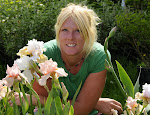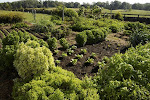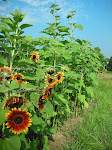
The majestic Peony flower has a past deeper and greater than I had ever considered. Writings of the Peony date as far back as 1000 BC. Traditionally known in the far east for it's medicinal purposes, it is known in the west mostly for it's ornamental purposes. The Chinese have long coveted the Peony not only for it's beauty but for the healing powers held with in the roots, stems, flower petals and the bark of the woody varieties. It is said that there were not many ailments that the Peony was not thought to cure~ tooth pain, child birth, jaundice, convulsions....... the list goes on depending on who was doing the healing and when. Europeans used the Peony for healing and also protection from evil spirits in the middle ages and if you look hard enough some culinary purposes were to be found as well.
There are 2 species of peony that are native to the western United States, Peaonia californica being one of them. I would love to come across one of these! They are beautiful too! The Peonies we know and love today were brought to North America by European settlers and were then cultivated in pioneer gardens. In 1904 the American Peony Society was born. The mission of this society was to "clarify nomenclature". There was at the time over 2,600 named peonies and a lot of inconsistency in the cultivation and sale. The University of Cornell studied the collection and compiled a list of 500 distinct and worthy varieties of ornamental herbaceous flowering peonies. The Peony was once placed into the Ranunculaceae family with the Helleborus and the Anemone and now is the only genus in the flowering plant family Paeoniacea. Today there are about 30 herbaceous species and 8 woody species that survived the test of time in our area.


From their beautiful buds to their larger than your face flowers with a fragrance straight from heaven, it is no wonder that these incredible plants have been admired, studied, saved, cultivated, painted, trucked across the world and planted across the world for over 2,000 years.


All that said, I can't help but to look at the Peony and think about estate gardens. I guess it's because I have grown up in Virginia and I associate Peonies with home. Every beautiful estate garden that I have seen has an abundance of Peonies.



 There are many myths surrounding the Peony. They say it's name came about after a student of Asclepius, the Greek god of medicine, named Paeon, was saved from the jealousy of his teacher by Zeus, who turned him into the Peony flower. It is also said that the Peony houses the soul of nature. Artists have spent life times trying to capture their likeness and I have yet to see a fragrance match the one that nature created.
There are many myths surrounding the Peony. They say it's name came about after a student of Asclepius, the Greek god of medicine, named Paeon, was saved from the jealousy of his teacher by Zeus, who turned him into the Peony flower. It is also said that the Peony houses the soul of nature. Artists have spent life times trying to capture their likeness and I have yet to see a fragrance match the one that nature created.





What a Peony brings to the garden is somewhat short lived but extremely worth the wait. They poke their curly beginnings up through the soil in mid march and before you know it they are almost 2 feet tall with tight stately buds. Waiting for those buds to open is one of the most anticipated events for me in the spring. Year after year I find myself thinking "when are they going to finally open?" then I have to remind myself that they will begin to open the last weekend in May. Memorial Day weekend you can be assured that in Virginia , the Peonies will open! And as promised, every year of my life, they have graced me with their presence on Memorial day weekend. Then before I know it they are finished! Then begins the slow decent back into the ground to hibernate for winter. It begins with the dead heading of the old blooms and continues on into the summer, as the heat and humidity come they retreat, only to reappear bigger and better than the year before!
There were only a few specimens when I arrived at the Goodstone, so one of my first orders of business was to correct that! This year was a great year on the farm for Peonies!
Not only are they magic in the garden but they last forever in a vase!

 There are many myths surrounding the Peony. They say it's name came about after a student of Asclepius, the Greek god of medicine, named Paeon, was saved from the jealousy of his teacher by Zeus, who turned him into the Peony flower. It is also said that the Peony houses the soul of nature. Artists have spent life times trying to capture their likeness and I have yet to see a fragrance match the one that nature created.
There are many myths surrounding the Peony. They say it's name came about after a student of Asclepius, the Greek god of medicine, named Paeon, was saved from the jealousy of his teacher by Zeus, who turned him into the Peony flower. It is also said that the Peony houses the soul of nature. Artists have spent life times trying to capture their likeness and I have yet to see a fragrance match the one that nature created.



The magic that is created in nature continues to go unmatched, though helped along and cultivated by mankind. It's not hard to understand why this flowering plant has been the center of attention for over 2000 years and continues to be adored to this day!






























